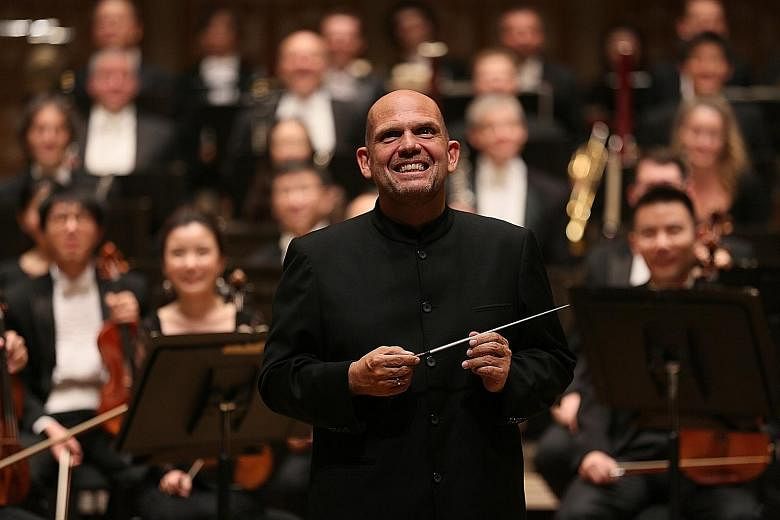Dutch maestro Jaap van Zweden helms the Dallas Symphony Orchestra and the Hong Kong Philharmonic - two orchestras with different histories and cultures - in exactly the same way.
"I am who I am, I cannot possibly change myself every week to suit a different person," says van Zweden in a telephone interview with The Straits Times, ahead of his May 1 engagement here with the Hong Kong outfit.
Approaching both orchestras, he sticks to his principle of "freedom by discipline".
"In order to freely express yourself on stage, you have to be in complete shape. I like to prepare as flawlessly as possible," says van Zweden, 57, who is music director of the two orchestras.
-
BOOK IT / HONG KONG PHILHARMONIC ORCHESTRA
-
WHERE: Esplanade Concert Hall, 1 Esplanade Drive
WHEN: May 1, 7.30pm
ADMISSION: $35, $50, $75 and $100 from Sistic (call 6348-5555 or go to www.sistic.com)
He will conduct the Hong Kong Philharmonic Orchestra at the Esplanade in a programme that includes the Singapore premiere of Quintessense, a contemporary piece by composer Fung Lam commissioned for the Philharmonic's 40th anniversary in 2014.
Other works in the programme include Mozart's Violin Concerto No. 4 and Mahler's Symphony No. 1. Violinist Ning Feng will be the soloist at the performance.
Having worked with the Hong Kong Philharmonic since 2013, van Zweden says there are advantages to working with what he calls a "young" orchestra.
"When you follow a young orchestra, you are able to help shape and be in its history and that is always very satisfying for a conductor," he says.
Some of the other orchestras he has worked with, including the Royal Concertgebouw Orchestra (RCO) in Amsterdam and the London Symphony Orchestra, have histories dating back to the early 20th century and even the late 19th century.
Dallas Symphony Orchestra was founded around 1900.
Van Zweden, who shuttles among Hong Kong, the United States and his home town of Amsterdam, continues to find it interesting and inspiring to work with different orchestras, even so for "old orchestras with a big ego".
Next year, he will take on the role of music director at the New York Philharmonic, after ending his term at the Dallas Symphony Orchestra.
The move to New York has special significance for van Zweden, who went there to study the violin at renowned arts school Juilliard when he was 16. "There is a feeling of closing the circle," says van Zweden, a father of four.
After graduating from Juilliard, he went on to become the concertmaster of the RCO at age 19.
He inadvertently stumbled into the world of conducting when his then-conductor Leonard Bernstein tasked him to take over as conductor for a few minutes during a practice session. He started taking lessons on the side and eventually decided to go into conducting full time.
Outside of work, his passion for music carries on in the foundation he founded with his wife to help autistic children and young adults.
The foundation focuses on music therapy, which the van Zwedens say helped them reach out to their third child, Benjamin, 24, who is autistic.
Although van Zweden is uncompromising with the two orchestras he helms, he notes that his son has changed him.
"I stepped into another very exciting, very beautiful world, but it's not easy to get into contact with him. I had to change from being very outgoing to learn to look inside myself."


